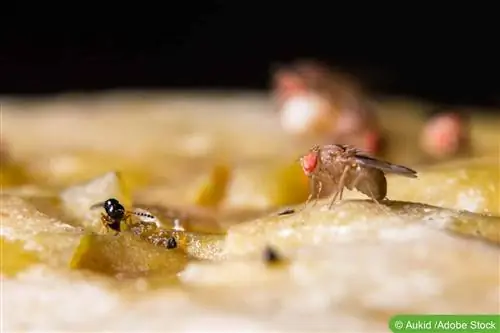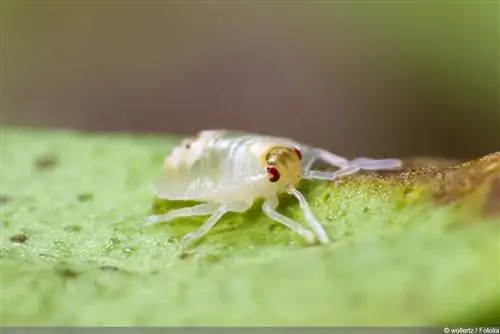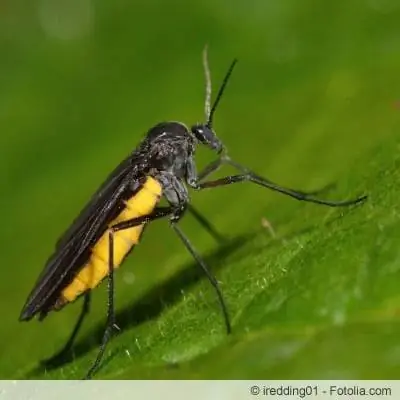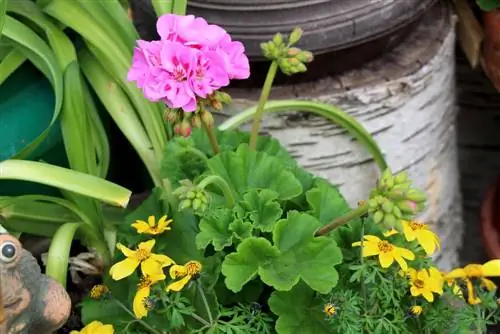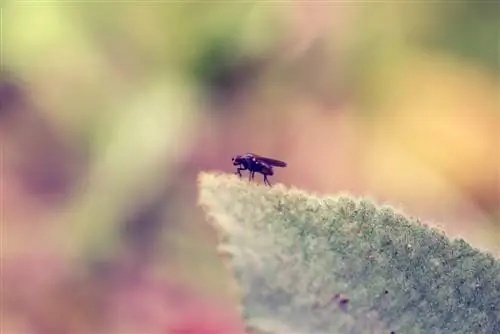- Author admin [email protected].
- Public 2023-12-17 03:39.
- Last modified 2025-01-24 12:45.
What is commonly known as fruit fly or fruit fly has the pleasant-sounding Latin name Drosophilidae and is also known as fruit fly. While the general name of the fruit fly comes from its preference for settling primarily on rotting fruit or fermenting substances, the name fruit fly arose from the behavior of the small insect: it prefers to fly in the morning and evening when the dew forms. In Austria, the small flies, like all doubter-winged insects, are referred to as mosquitoes.
The habitats of fruit and fruit flies
Fruit and fruit flies, as the name suggests, love fruit and especially fruit that is already lightly pressed. This happens quickly and just one touch of the finger is enough to start an initially minimal putrefaction process. The nectar that ferments as a result of this process attracts the flies and ensures that they reproduce at a record-breaking rate. But how do they reproduce?
Even if the animals are so small, they mate and even use courtship to do so. This process is used to detect and identify virgin females, whose attractant is perceived by male fruit flies in the area. After mating, females can lay up to 400 eggs. The ideal place for this is a fermenting plant substance that serves as food for the larvae.
- There are more than 3,000 species of fruit flies worldwide.
- Approximately 50 species live in Germany.
- There are wild species that need the habitat of woody plants.
- There are cultural followers that can be found in human habitat.
What living conditions do fruit flies need?
Fruit flies are the same as wasps and bees; they smell from a great distance where something rotten is standing or lying around. Especially in summer, when there is an abundance of ripe fruit in the garden, they appear out of nowhere. But not only the garden fruit, but also the fruit bought in the supermarket or from the fruit dealer attracts the fruit fly. It may also already be infested with fruit fly larvae and so you can bring them into the house. Considering that a female fruit fly can lay her eggs in a bag of fruit, the damage is easy to imagine.
Fruit flies, like many other animals, like it warm in order to reproduce. They can hatch best at 25°C, because fruit flies actually come from the tropics. The most common types of cultural followers in our country are called:
- Drosophila melanogaster
- Sophophora simulans
- Drosophila funebris
Drosophila melanogaster is the most common fruit fly in our region. It is up to three millimeters long, has a yellow-brown color and red eyes. It is the most researched object of study in genetics. A pair of fly parents can quickly produce 100,000 offspring in a month. However, a big mystery has not yet been solved: Where do the fruit flies stay in winter?
Preventing fruit from being infested with fruit and fruit flies
Even though fruit flies can be useful for research, they are not at all popular with consumers. Fruit flies and fruit flies not only cause the fruit to rot more quickly, they also transmit germs and bacteria. The fruit fly not only stays on the fruit in the fruit bowl, it also flies on organic waste that is collected in the kitchen or apartment. Simply because of the transmission of germs, fruit or fruit juice should always be kept well covered and is best stored in the refrigerator in summer.
Tip:
Wash fruit peels more often in summer
There are small hoods made of mesh or fine mesh on the market that are placed over the fruit basket and are intended to keep fruit flies away. However, if the grid is too coarse, small flies can easily crawl through it. This may be a solution for some housewives, but it is not very practical. These basic rules of conduct should help reduce or even prevent fruit fly infestations:
- Put used dishes and cutlery in the dishwasher immediately or wash them.
- Rinse open empties as well, fruit flies also like juice or lemonade.
- Empty trash and compost bins regularly and keep them meticulously clean.
Fruit fly traps are very effective
With these basic rules of behavior you can reduce the ideal habitat for fruit flies. If you now ensure that the fruit is not left open, the number of little pests will visibly decrease. If there are already fruit flies in the apartment, so-called fruit fly traps can help. These traps either work on the principle of a glue trap or are made yourself.
Build your own trap
All you need is some sweet juice, preferably apple juice, and a little dishwashing liquid. Put some apple juice in a small bowl. The sweet smell attracts fruit flies. But if a fruit fly gets hold of the juice, that doesn't mean that you've successfully fought it. The surface tension of the juice is often so high that the flies do not sink but can escape the trap. If you put a few drops of detergent in the bowl, this reduces the surface tension and the fruit flies cannot escape the trap, but are immediately trapped by the mixture.
Tip:
Fruit fly traps for filling with vinegar are commercially available
If you don't want to risk the animals dying by drowning despite their unpleasant presence, you can also ensure that they are caught in other ways. In this case, a banana peel is placed in an open plastic bag. When a lot of animals have gathered on it, the bag is closed and transported outside, where the flies are either released or go into the garbage can.
Yellow sticker
Yellow stickers are yellow plastic boards that are coated with an adhesive. The yellow color attracts the fruit flies and once touched, the fruit fly cannot escape the adhesive. For aesthetic reasons, you should not place the boards in the middle of the kitchen table, but rather in niches and on the window sill and replace them with new ones more often.

